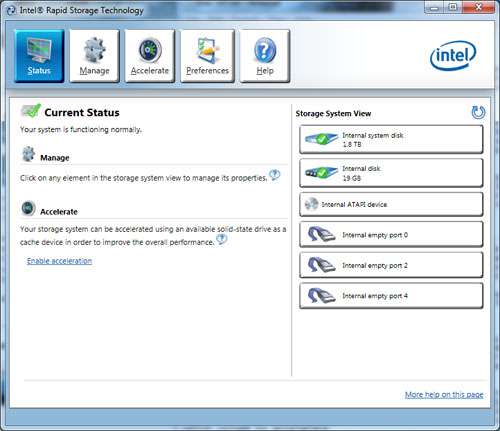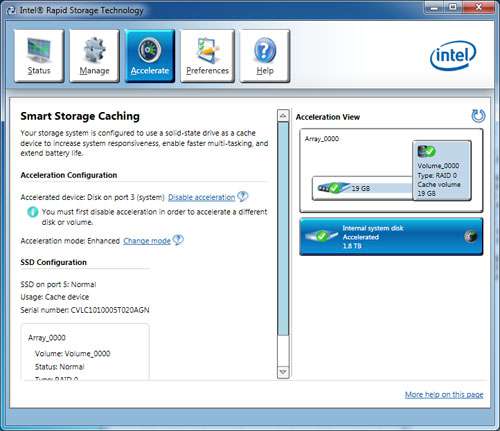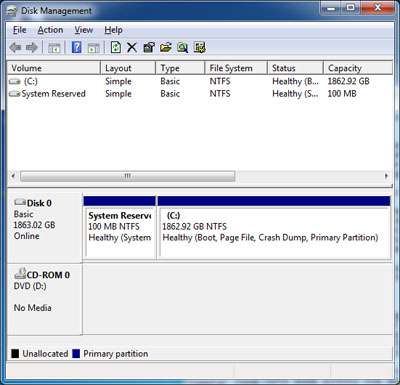- Qualcomm Launches Snapdragon 4 Gen 2 Mobile Platform
- AMD Launches Ryzen PRO 7000 Series Mobile & Desktop Platform
- Intel Launches Sleek Single-Slot Arc Pro A60 Workstation Graphics Card
- NVIDIA Announces Latest Ada Lovelace Additions: GeForce RTX 4060 Ti & RTX 4060
- Maxon Redshift With AMD Radeon GPU Rendering Support Now Available
Intel’s Smart Response; SSD Caching Tested
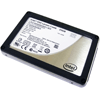
Interested in faster-than-mechanical performance but don’t want to splurge on a big SSD? Intel has a tech for that, and it meets you half-way by utilizing a modestly sized SSD for caching purposes, used in conjunction with any HDD you want for total storage. Read on as we cover both the setup process and our real-world test results.
Page 2 – Configuration
Rapid Storage Technology, like anything else, has some basic requirements. The solid-state drive being used must have at least 18.6GB of free space and can be as large as 64GB. Users can choose how much room they wish to devote to caching information, meaning that on larger drives they can leave some room to use as they see fit.
Currently, Rapid Storage Technology only allows for one solid-state drive to be used to accelerate one volume. If there are multiple volumes that the user would like to accelerate, the choice will have to be made.
Assuming the hardware is up to the task, there is some prep work that needs to be done and the basic setup goes like this. First, the SATA mode within the motherboard BIOS must be set to RAID before installing the operating system. That’s right… we unfortunately lose AHCI functionality with SRT. Once done, drivers can be installed followed by the Rapid Storage Technology application where users can select the drives to be used.
Upon opening the application, users will see a list of available drives on the right with green checkmarks indicating that they can be used. To enable acceleration, you can access the Accelerate section and click the Enable acceleration link. Easy so far, right? Upon doing so, a pop-up will be displayed where users can choose which solid-state drive they wish to use, how much of the drive they wish to use for caching data, which drive to accelerate and which acceleration mode to use.
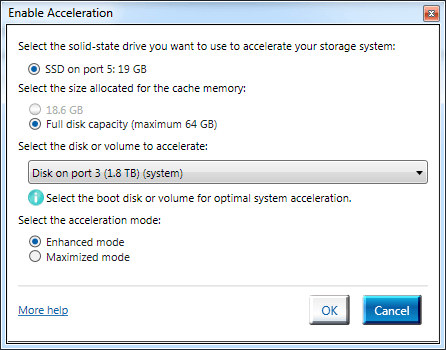
By default, Rapid Storage Technology will be setup in enhanced mode. This mode reads and writes or caches the data on the solid-state drive at the same time as data is written to the hard drive. This translates into high read speeds once the data is cached but the write speed will be reduced to the maximum speed of the hard drive.
Maximum acceleration can be chosen at any time from the Accelerate section of the Rapid Storage Technology application by clicking on the Change mode link. This mode reads and writes data to the solid-state drive while only writing to the hard drive at intervals and allows for the fastest overall performance – but at a cost. Since data is only being written at intervals, there is a possibility of data loss if the solid-state drive fails, whereas enhanced mode writes to both drives simultaneously so data loss is not an issue.
If for some reason there is a need to remove the solid-state drive from the setup and revert back to using solely the hard drive, or you need to switch the configuration around all together, it is as easy as opening the Rapid Storage Technology application, removing the existing solid-state drive and selecting a new one or switching over which volume is to be accelerated. There is also an option to make a solid-state drive available again which removes all cached data. In any of these scenarios, new data will need to be cached again before any performance increase is noticed.
Another thing worth mentioning is that although the solid-state drive is listed in the Rapid Storage Technology application, it will not be listed in anywhere else within Windows. Both drives will show as a single volume with the total size being that of the accelerated hard drive, not the size of the drive plus the solid-state drive.
Now that you know what it is, how it works and how to set it up, it’s time to have a look at just what it can do in terms of improving performance.
Support our efforts! With ad revenue at an all-time low for written websites, we're relying more than ever on reader support to help us continue putting so much effort into this type of content. You can support us by becoming a Patron, or by using our Amazon shopping affiliate links listed through our articles. Thanks for your support!




